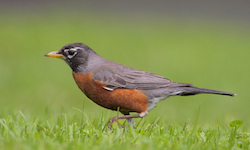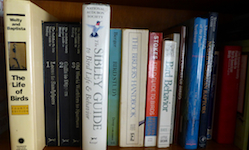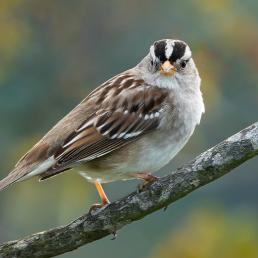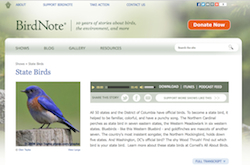

Join BirdNote tomorrow, November 30th!
Illustrator David Sibley and actor H. Jon Benjamin will face off in the bird illustration battle of the century during BirdNote's Year-end Celebration and Auction!
Observe birds, research species, and create a book of local winter birds.
A one to two week project for grades 6-12
|  |  | ||
| Summary | Lesson Plan |
Summary

Joyanne Hamilton teaches students at Innoko River School in Shageluk, Alaska. She has students listen to BirdNote shows to gain general knowledge about birds and stimulate their interest in issues involving birds. Students then observe birds at classroom feeders and on walks or drives around home. They learn to identify local winter birds and collect data on species and numbers. Along the way, they build a knowledge of bird characteristics, scientific observation techniques, field guides, and online resources. Students also associate local bird species with indigenous names, stories, and traditions. Each student chooses one local bird and creates an information page for the bird book that the class compiles for all to use. The students participate as "citizen scientists" when the class contributes the collected data to Project FeederWatch.

Title: Create My Bird Book
Duration: 1-2 weeks
Setting: Indoors and outdoors
Subject Areas: Science, Language Arts, Math, Technology
Next Generation Science Standards: LS2.A, LS2.C, LS2.D, LS4.C
Common Core Standards: CCSS.ELA-LITERACY.RST.6-8.7
Grade Level: Grades 6-12
Lesson Objectives:
• Students will observe local birds and their behavior at the classroom feeder and in the field.
• Students will learn to identify local winter birds, develop tally sheets, record data on species and numbers, and seek to understand observed behavior.
• Each student will choose one bird and research that specific bird using various resources.
• Each student will collect indigenous names, stories, and traditions associated with his or her chosen bird.
• Each student will create one page of information on that bird for a classroom bird book.
• The class may submit the combined collected data on species and counts to Project FeederWatch.
How BirdNote Is Used: To stimulate learning and discussion of issues in the BirdNote story, e.g., bird behavior, characteristics, natural history, environmental issues, bird lore, etc.
Materials: bird books and guides, indigenous stories, computers for online research and wordprocessing, bird feeders and seed, digital cameras, tally sheets, BirdSleuth or Project FeederWatch online subscription ($18/class) for digital data submission.
Lesson Plan
1. Motivate: Listen to BirdNote stories to inspire students interest in birds and their behavior. Provide a classroom feeder station for easy observation of bird behavior and characteristics. The Shageluk class has both seed and suet feeders set up outside the classroom window. Also, encourage students to observe birds elsewhere during their activities outside of school.

2. Teach: Introduce students to techniques for observing birds and identifying species. This includes teaching students about bird characteristics that help with identification, such as shapes and silouettes, beak sizes and shapes, songs, and calls. Start with a common, easily identifiable bird so students can gain skills and be successful. For example, in Shageluk they might start with a male Pine Grosbeak and next the female Pine Grosbeak. Then they might learn to identify chickadees and redpolls - birds of similar size but with very different shape and plumage.
3. Do Activity:
• Students observe birds and learn to identify species realiably using their knowledge of characteristics.
• Students develop tally sheets for species identified and keep data on the number seen at feeders, at home, on walks, or on drives.
• Students can also take photos and/or set up feeders elsewhere in the area for observations. As time and materials allow, students might make feeders at home or at school.
• Each student chooses a bird from the list of birds identified and collects information on that bird.
• Research should include markings, size, calls and songs, range maps, behavior, and indigenous bird names and stories.
• The students also document the websites and other sources they use and share those with others.
• Each student completes a template that will become a page in the class's local bird book.
• The class can submit the data collected to Project FeederWatch website.
Extension: This lesson could be revised as a year-long advanced migratory bird study. It might include partnerships with other countries that share the migratory birds.
Conservation Ideas/Projects: Students could start (or join) a cross-continental study of migratory birds. Data and environmental concerns would be documented and exchanged with students in other areas sharing the same birds.
Resources
BirdNote podcasts
Project FeederWatch
BirdSleuth
Do you have a lesson plan to share? Check out the guidelines, then download the submission form. Thank you!
<< Back to Educators Who Use BirdNote

